
|
By H. P. Oliver As you already know, I am a big fan of 20th Century history, particularly that of the west coast during the period between WWI and WWII. I call this period in time the "Swing Era" and thoroughly enjoy studying its social history. One of the frustrations accompanying this interest, however, is that we tend to think of the era in black and white because that's how we see it in still photographs and motion pictures of the day. So, unless we actually visit the bits and pieces of Swing Era history that remain, we must use our imaginations to get a more realistic picture of the period. If you share this frustration, I'm about to show you something that will please you no end. MEET LARRY GROSSMAN This feature is about the work of southern California artist, Larry Grossman. Larry's formal education in the arts includes the study of photography and cinematography at the California College of the Arts. After graduation, he pursued his interest in motion pictures, single-handedly producing Rude Vagabond, an animated short that won the Grand Prize at the Joint CCAC/San Francisco Art Institute Film Festival. Larry also wrote, produced and directed the acclaimed feature film, The Big Sleeze. These successes earned Larry Grossman a position at the Disney Studios, where he worked on the first computerized film, TRON. Being part of the TRON team heightened his interest in computer generated graphics, but he had to continue painting with an airbrush until such time as the home computer became a reality. During this period Larry airbrushed many logos, illustrations and merchandise designs for major motion picture studios, including Disney, Warner Bros., and DreamWorks. Larry also illustrated three album covers for the legendary Frank Zappa, and another for Hank Williams, Jr. By the mid-1990s home computers had become more powerful and fairly affordable, so Larry was finally able to make the transition to digital art. Combining his photography, film, and airbrush skills with his computer skills, he created a unique visual style all his own. RETROVISIONS Larry labeled this unique new style Retrovisions. Simply put, Retrovisions are digital images which combine Larry's love of architecture, design, and photography with his passion for the styles of the 1920s through the 1950s. Beginning with one of the many quality photographs he's shot over the years, Larry applies his digital magic to take us back in time for an amazingly lifelike period view of a landmark building, automobile, aircraft, railroad train, or some other vintage subject. Adding to the realism of Larry's work is a cinematic flair--the influence of his talent as a filmmaker--that leaves viewers with a sense that at any moment the people and vehicles in his Retrovisions may suddenly pop into action, just like a motion picture. And, ala Alfred Hitchcock, Larry also gets a kick out of occasionally making cameo appearances as a period character in his work. He's even willing to do the same for you, but more about that later. |
| Larry Grossman in a portion of the whimsical, animated front page image from his Retrovisions website. The original is, in its own right, worthy of a visit to the site. |  |
|
That Larry shares our interest and fascination with the past goes well beyond his art and is clearly evident in his surroundings. He quite literally lives a retro lifestyle, from the art deco furnishings in his home and his collection of vintage clothing right down to his automobiles, a Nash Metropolitan convertible and a chopped and flamed, Chevy-powered Deuce Coupe--a hotrod in the classic style of the 1950s. Larry Grossman's work so accurately captures the eras and styles it depicts that Retrovisions images can be found at galleries and museums worldwide, including the National Hot Rod Association (NHRA) Museum in Pomona, California, and the famed Petersen Automotive Museum in Los Angeles. Larry's work is also becoming very collectible, and with good reason. His innovative Retrovisions capture the past in ways that have seldom been seen before. The results are stunning! I'll show you what I mean. THE GALLERIES Larry Grossman's website, Retrovisions (http://www.retrovisions.com), is a virtual art gallery where you can view and purchase his work. The site includes six mini-galleries devoted to the elements of the period he finds interesting. Two additional mini-galleries display unique applications for his artwork. What follows here are samples of the images found in Larry's galleries. Be sure to read his notes about each image when you visit the galleries. |
|
GALLERY: CARS - RODS - BIKES It's obvious that Larry Grossman is a car and bike nut, and he expresses that love of rods and choppers through some very cool images. What I enjoy about these pictures is how they so completely capture the art and spirit of hot rodding. |
|
Cruisin' Bob's -- Summer of '62 In addition to the famous Toluca Lake (Burbank) Bob's Big Boy restaurant this image includes, in Larry's words, "one of the most famous cars in Hot Rodding history, Norm Grabowski's iconic 'Kookie T'. This cool car was driven by hipster Ed 'Kookie' Byrnes in the classic '60's TV series 77 Sunset Strip, and was also the very first T bucket rod ever built!" |
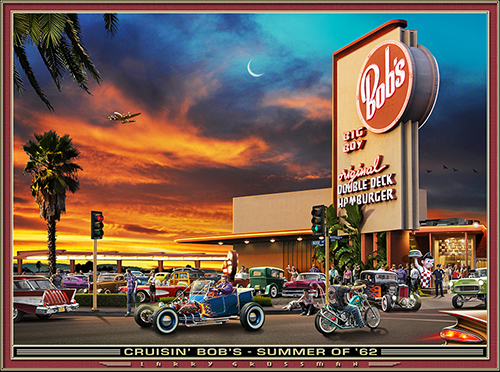 |
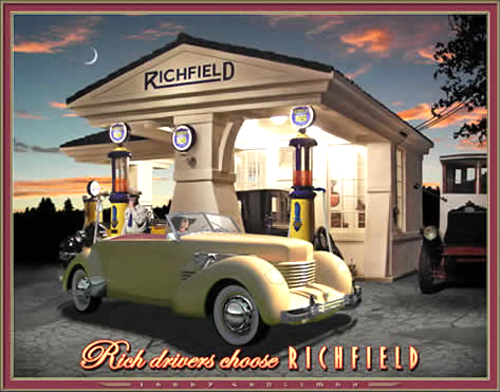 |
Rich drivers choose Richfield "The classy lady driving this beautiful 1937 Supercharged Cord 812 Sportsman fills up at this equally beautiful Spanish-style Richfield station. Uh-oh, that attendant must be new on the job (or just plain stupid), as he obliviously puffs away on a cigarette!" -- L. G. |
|
GALLERY: DINERS - STORES In this gallery Larry takes us on a virtual tour of unique diners and classy Los Angeles department stores of another era. While not all of the eateries he depicts actually existed, they are all so reminiscent of the era you'll find your mouth watering for a Tail of the Pup hot-dog. |
|
The Brown Derby "Opened in 1926, this is probably the most famous whimsically themed restaurant in the world. Very popular with all of the glamorous film stars of Hollywood's heyday, 'The Derby' was located on Wilshire Boulevard right across the street from the famous Cocoanut Grove night club (located in the Ambassador Hotel, which is where Robert Kennedy was shot). Unfortunately, it was torn down and replaced by a strip mall in 1980!" -- L. G. |
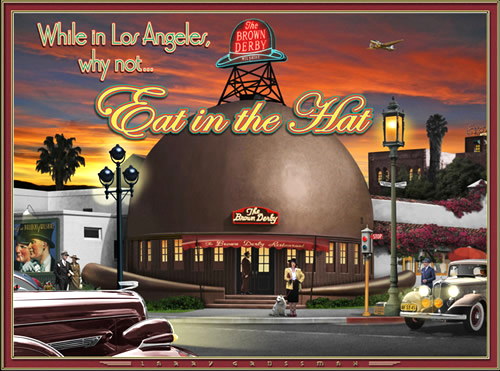 |
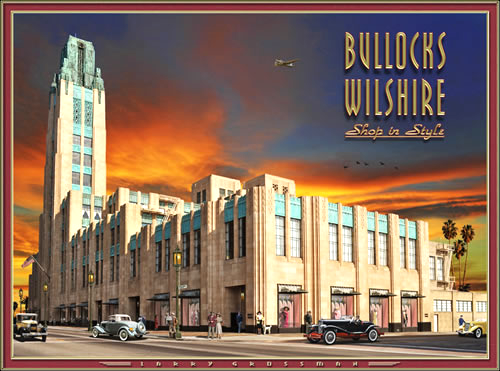 |
Bullocks Wilshire "Built
in 1929 on Wilshire Blvd. in Los Angeles, department stores were never
more Art Deco elegant than this. In it's glamorous heyday, it was 'the
luxury place' to shop for both film stars, and all of the upper crust
of L.A. society. Unfortunately, in 1994 it was converted to a law school
(but at least it still stands!)." |
|
GALLERY: MOVIE PALACES This is my favorite gallery. In it you'll find living, breathing images of southern California's most memorable motion picture theaters, from Grauman's Chinese to the Pantages. Larry has also included the iconic Paramount Studios entrance gate and the RKO studio building with its famous world globe. |
|
The Bruin "Opened in 1937, the Bruin Theatre is located directly across the street from the Fox Westwood Village Theatre, and only one block from the University of California at Los Angeles (UCLA - home of the 'Bruins') in Westwood Village California. In this scene, it's a rainy night and the 1942 film classic Casablanca, starring Humphrey Bogart and Ingrid Bergman is on a double bill with the 1941 film Dive Bomber starring Errol Flynn." -- L. G. |
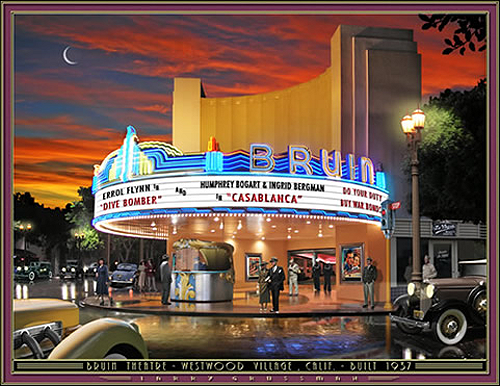 |
 |
The Return of Norma Desmond "Depicted
is a scene from the Academy Award winning 1950 Billy Wilder film Sunset
Boulevard, starring William Holden and Gloria Swanson. In this
pivotal shot, Norma Desmond (Swanson), a faded silent era movie star,
returns to the Paramount Studios in Hollywood for what she believes
to be her triumphant return to filmmaking, after decades of reclusion.
She is accompanied by William Holden's character Joe Gillis (who narrates
the entire film, despite the fact that he is found dead in a swimming
pool in the opening scene!), and driven by famed director Eric von Stroheim
in a 1920's era Hispano-Suiza chauffeured touring car." |
|
GALLERY: PLANES & TRAINS From war birds to Glendale's celebrated Grand Central Air Terminal, this gallery is a tribute to the glory days of mid-20th century aviation. But before there were airplanes, trains were the ultimate in long-distance transportation, and you'll also find several of the best known trains depicted here, including the streamlined 20th Century Limited, Santa Fe's Super Chief, and Southern Pacific's Daylight. |
|
P-38 Lightening over the Pacific "The Lockheed P-38 is perhaps the most recognizable plane of WWII. With its distinctive twin-boom design and dual turbochargers it performed well in all theaters of the war. It is seen here in it's natural aluminum finish. Although most German fighter planes outflew it, the Germans nicknamed it the 'Fork-tailed devil.' It is also credited with shooting down General Yamamoto in a well timed ambush that was a major blow to the Japanese." -- L. G. |
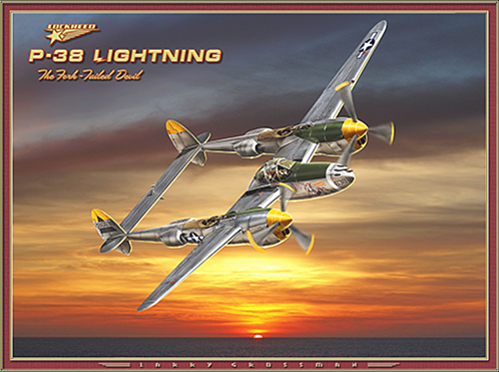 |
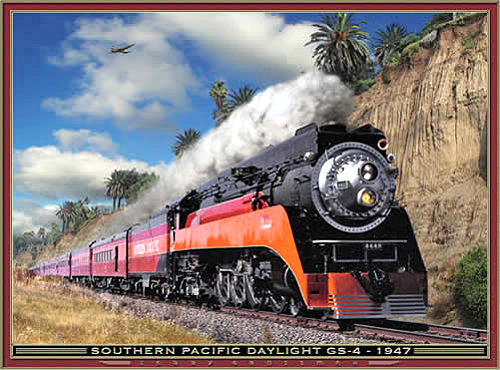 |
Southern Pacific Daylight "A Southern Pacific Daylight GS-4 streamlined steam locomotive passenger train speeds along past Pacific Coast bluffs topped with palm trees, as a Douglas DC-3 passenger plane passes overhead." -- L. G. |
|
GALLERY: GRAPHICS - LOGOS This gallery is filled with familiar graphic designs from the past. Starting with In and Out Burger's 2010 T-shirt and moving on through Frank Zappa album covers and good old Bugs Bunny, these visual icons bring back fond memories for the baby boomer set. |
|
Left: Frank Zappa album cover. Right: Bugs Bunny Warner Bros. design. |
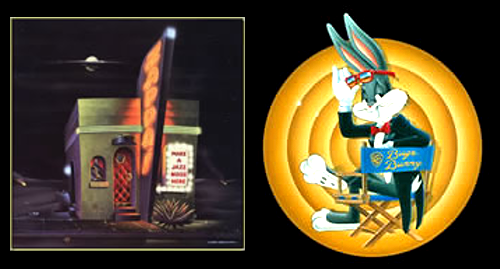 |
|
GALLERY: VINTAGE NEON Neon signs are an integral part of our social history, and Larry gives us some examples so realistic you'd swear you can hear them humming. Included here are lounge signs like the Boom-Boom Room, along with coffee shop/diner neon, and theater marquees. |
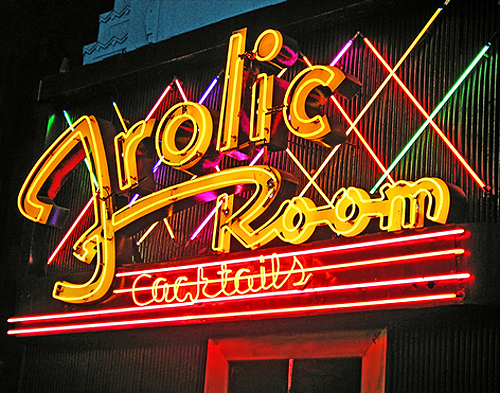 |
Lounge neon: Frolic Room |
|
METAL SIGNS The first of the remaining two galleries features Larry Grossman's art applied to heavy gauge American steel plates using a unique powder coating process that results in vibrant, long-lasting images. They are a great way to "class up" a rumpus room or your garage. |
|
A steel sign imprinted with Larry Grossman's "1938 Dubonnet Xenia," one of many designs available. |
 |
|
CLOCKS Here you'll find Larry's images powder coated and baked onto clock faces under the personal supervision of the artist. This is as classy as kitsch can get! |
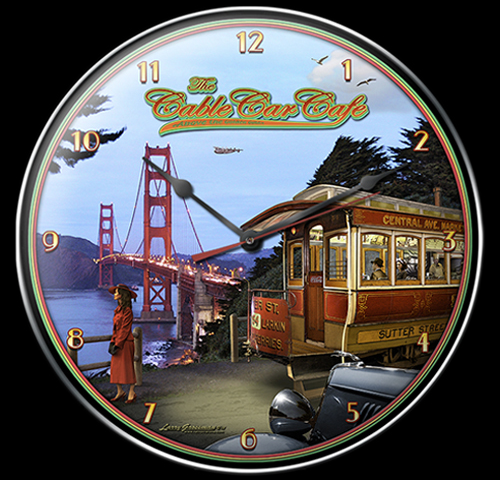 |
Classic 14" quartz-movement clock featuring Larry Grossman's "Cable Car Cafe." |
|
PURCHASING YOUR OWN RETROVISIONS In addition to the metal signs and clocks just mentioned, Larry Grossman's Retrovisions are available in a variety of media and sizes, including wall-sized banner art, lithographs, and Giclée prints on canvas or paper. His prices begin at $30 for a 9" x 11" lithograph ($35 for a signed print). Giclée prints range from $30 for an 8" x 10" paper version on up to $200 for a 25" x 33" print on canvas. You'll find all of the information you need to order Larry's images on his clever, easy to navigate website (http://www.retrovisions.com). What's more, Larry can even put YOU, YOUR CAR, DOG, WIFE . . . WHATEVER, in the picture! That's right, for a few extra bucks, you can appear in a Larry Grossman image. What could be more cool than that? Note:
All of the images on this page are © 2014 Larry Grossman. All Rights
Reserved. |

.